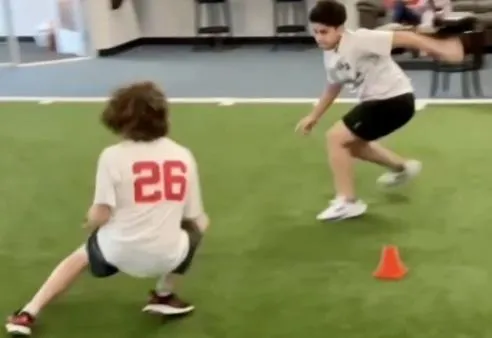ATHLETE BLOG LEOMINSTER

Why Most Speed Training Won't Help You To Get Noticeably Faster
Parents, coaches and trainers may not always agree, but there is one thing we all definitely do agree on.
We want to see our kids get faster.
Parents spend billions of dollars annually in the US alone to accomplish this, through equipment purchases, online workouts and in person training.
Coaches in most team sports typically use some practice and off-season time focused on speed development.
So do strength coaches and personal trainers.
My point?
A lot of time and money is devoted to speed development.
Unfortunately, though, the results are typically disappointing.
Now, this isn't meant to be a knock on anyone.
In fact, it is quite the opposite.
Because if you as a parent or coach have poured resources into helping your kids, you have your heart in the right place.
And you deserve to know how to fix it.
One of the positives of being an old and experienced coach is that you've made all the mistakes before, and can accelerate the learning curve for others.
That's what I'd like to do for you here.
There's really just 3 main lessons that were game changing in regards to how we do speed development in our programs.
Here they are.
Lesson #1 - You Have To FORCE Change
When we purchased a 1080 Sprint last year, my hope was that the data it provided would help us to teach speed more effectively.
6 months later, what is now obvious is that the power of properly using resisted and assisted sprinting is what truly turbo-charges a kid's speed development.
We can talk to our athletes all day about angles and positions, but when they have to run full speed against the right amount of resistance they tend to find better technique fairly quickly.
Same goes for assisted sprinting, where your sprint coordination must improve on the spot to keep up with the speed of the cord.
When you create an environment that gets an athlete to feel what they're supposed to do as a sprinter, they improve much more quickly than when they just have to think about their technique.
Of course we still work on technique separately, because it does have value.
It's just become more of a side dish than a main course.
Lesson #2 - You Have To Create The Right Conditions, & Stick With It
This is really a lesson in two parts.
First, your group needs to be motivated to get faster.
If you run at anything less than 95% effort there simply won't be enough of a challenge to your nervous system for it to have to adapt and improve.
Going right along with that, you have to rest long enough between sprints to be able to maintain that 95-100% maximum velocity.
If you don't, it simply becomes a conditioning drill that will have zero impact on speed development..
Based on experience, middle and high school age kids need at least 30 seconds rest for every 10 meters long the run was (10 yds = 30 sec, 20 yds = 60 sec, etc).
By sprinting at 95% or greater for even just a couple sprints each day, with proper rest in between, athletes will get faster.
Speed development can take a bit longer to develop than other skills, but those who move at full speed regularly do improve quite a bit over time.
Lesson #3 - Then It Needs To Become Transferrable To Sport
It can be thrilling to see your sprint times improve by a few tenths of a second.
But will it translate to better play when you get back to your sport?
Team sports aren't played exclusively in a straight line.
You also have to develop agility, or change of direction skills, for it to transfer to sport.
In the past we relied mostly on patterned, rehearsed footwork drills to enhance agility.
Everything looked nice, and kids seemed to be mastering skills.
Then they couldn't apply those skills under game conditions.
When we built on those footwork drills by doing more reactive, chaotic drills that required athletes to adapt to their surroundings, everything changed for the better.
Long gone are agility ladders, patterned drills and the like when we get to our change of direction training.
Our actual training might look a little messier now, but because our kids must think and react along with showing great footwork, the gains they see transfers far, far better.
This is the blueprint we use in our Speed Development sessions.
And on the days where every kid is working hard and dialed in, we've seen some really amazing progress through these three simple but powerful lessons.
Power Source Reviews
© Copyright 2024. Power Source. All rights reserved.
|
